It is the largest painted panel of the 13th century known to us: an imposing work four and a half meters high by nearly three meters wide. It is the Rucellai Madonna, an extraordinary masterpiece by Duccio di Buoninsegna (Siena, c. 1255 - 1319), which today greets visitors to the Uffizi Gallery in Florence at the beginning of the museum’s tour. It is a work whose history we know very well: the work was commissioned on April 15, 1285, from the great Sienese painter by the Compagnia dei Laudesi, a confraternity that had been formed in Florence in the mid-13th century, and which requested the panel in order to destine it for the church of Santa Maria Novella, where the Laudesi habitually gathered. In his Lives, Giorgio Vasari, who attributed the panel to Cimabue (Florence, c. 1240 - Pisa, 1302), described it as “placed high up between the capella de Rucellai and that de Bardi da Vernia.”
Originally the Rucellai Madonna was probably in the place where Vasari had seen it. Only in 1990 did scholar Irene Hueck clarify what the painting’s original destination might have been, inside the church of Santa Maria Novella: not the chapel of San Gregorio, which passed to the Bardi family in 1336 (this is the Bardi chapel later decorated perhaps by Pseudo Dalmasio, a painter active around the middle of the 14th century who painted in the style of Dalmasio di Jacopo Scannabecchi), since the relations the Laudesi had with this chapel were pittusto labile, nor even the high altar, but rather an area of the church located just between the Bardi chapel and the Rucellai chapel. Duccio’s work owes its name today to the fact that, in 1591, it was moved right into the Rucellai chapel: that is where the scholar Francesco Bocchi saw it, describing it in his work Le bellezze della città di Fiorenza, published that year. And it was still there in the mid-eighteenth century, when historian Giuseppe Richa published his Notizie istoriche delle chiese fiorentine, between 1754 and 1762. And it remained there until 1937, when it was moved for a major exhibition on Giotto at the Uffizi.
It was on that date that the Rucellai Madonna returned to the center of scholarly attention. "Never has the Rucellai Madonna been seen so well,“ Pietro Toesca wrote to Bernard Berenson after visiting the exhibition, ”and those of the other Madonnas that have so much affinity and so much diversity with that one (Gualino, Mosciano, etc.) have appeared so close." The work finally reached the Uffizi in 1948, on deposit from the church of Santa Maria Novella: and the Rucellai Madonna, from that date, although not formally the property of the Uffizi, has never moved from the Florentine museum. Three great personalities of twentieth-century architecture, namely Carlo Scarpa (Venice, 1906 - Sendai, 1978), Giovanni Michelucci (Pistoia, 1891 - Florence, 1990) and Ignazio Gardella (Milan, 1905 - Oleggio, 1999), who devised a special “Hall of Majesties” where Duccio’s Madonna Rucellai could profitably dialogue with Cimabue ’s Majesty of Santa Trinita and Giotto ’s Madonna of All Saints (Florence?, c. 1267 - Florence, 1337). And this is where the work still stands today.
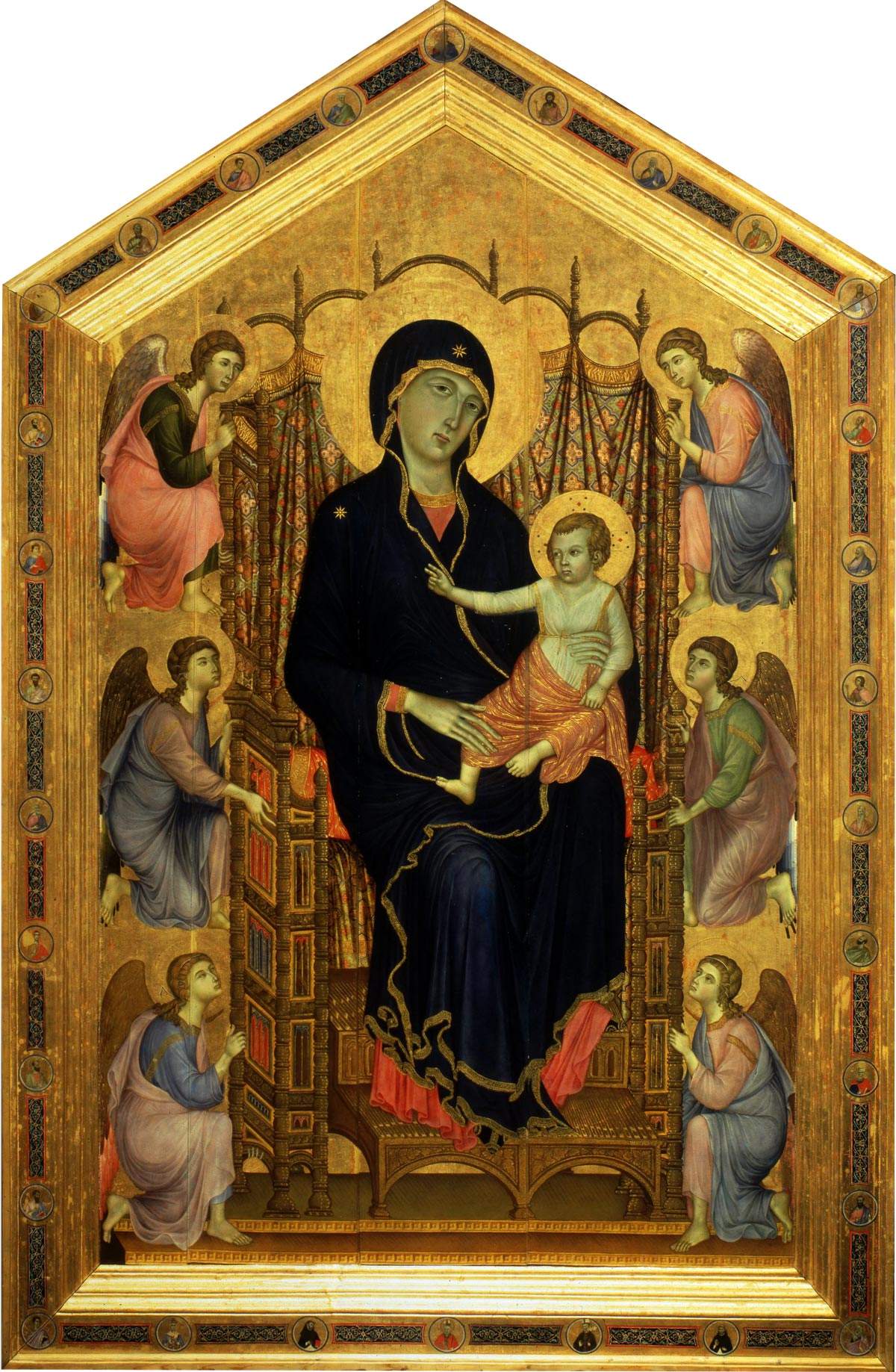 |
| Duccio di Buoninsegna, Madonna and Child Enthroned and Angels, known as Madonna Rucellai (1285; tempera on panel and gold ground, 450 x 290 cm; Florence, Uffizi Gallery, on deposit from the church of Santa Maria Novella in Florence, City of Florence) |
| <img src=“https://cdn.finestresullarte.info/rivista/immagini/2021/1577/sala-maesta-uffizi.jpg ” alt=“The Majesties Room of the Uffizi (pictured are works by <a href=”https://www.finestresullarte.info/arte-base/giotto-vita-opere-principali-importanza“>Giotto</a> and Cimabue) ” title=“The Majesties Room of the Uffizi (pictured are works by Giotto and Cimabue) ” /> |
| The Majesties room of the Uffizi (works by Giotto and Cimabue can be seen in the photo; the Rucellai Madonna is on another wall) |
Throughout its history, the Rucellai Madonna has not always been correctly referred to Duccio: as anticipated, Vasari attributed it to Cimabue, and for a long time the large panel was believed to be the work of the Florentine artist. Vasari, even, in the Lives reports a singular anecdote: “la qual opera,” wrote the great historian from Arezzo, “was of greater grandeur, than figura che fusse stata fatta insin a quel tempo; et alcuni Angeli che sono intorno le, mostrano, ancor che egli aveva la maniera greca, che sandò accostando in parte al lineaamento e modo della moderna, onde fu questa opera di tanta maraviglia ne popoli di quelletà, per non si esser vederlo insino allora meglio, che da casa di Cimabue fu con molta festa e con le trombe, alla chiesa portata con solennissima processione, et egli perciò molto premiato et onorato”. According to Vasari, the work was so appreciated that the Florentines accompanied it with a great and festive procession to the church of Santa Maria Novella. The tale evidently appealed greatly to one of the leading English painters of the nineteenth century (at the time, in fact, no one had yet questioned the alleged Cimabuesque authorship of the Rucellai Madonna), Frederic Leighton (Scarborough, 1830 - London, 1896), who depicted in 1855 the imaginary procession in one of his paintings now in the National Gallery in London, also included Dante Alighieri, Arnolfo di Cambio, Gaddo Gaddi and, anachronistically, Simone Martini and Buonamico Buffalmacco in the procession.
Even at the end of the 19th century, several art historians largely ascribed the Rucellai Madonna to Cimabue: among the few who had correctly referred it to Duccio was Gaetano Milanesi, who in 1854, scanning a 1790 work by a Florentine friar, Vincenzio Fineschi (the Memorie istoriche che possono servire alle vite degli uomini illustri del convento di S. Maria Novella in Florence), he had noticed that a document published by Fineschi himself (dated April 14, 1285 and now preserved at the State Archives in Florence) was none other than the document of allogation of the painting. Even Milanesi’s discovery, however, was not enough to move many from the conviction that it was a painting by Duccio, and the debate continued for a long time, until the aforementioned 1937 exhibition that closed the debate once and for all, and this despite the fact that the great scholar Franz Wickhoff had published again in 1889 the document attesting to the commission to Duccio of the panel by the Laudesi company, reaffirming more firmly and convincingly its connection with the Rucellai Madonna.
In the allogagione document, the Laudesi commissioned the Sienese painter to “dictam tabulam depingere et ornare de figura beat[a]e Mariae Virginis et eius omnipotentis Filii et aliarum figurarum.” In spite of this, there were still those who did not believe that the “tabulam” mentioned in the document could be identified with Duccio’s painting, and consequently there were also those who, like Wilhelm Suida, tried to hypothesize a “Master of the Madonna Rucellai,” an intermediate personality between Cimabue and Duccio to whom the large panel could be assigned. Still others spoke of a collaboration between the two (among them the Finnish Osvald Sirén, according to whom the work was begun by Duccio and finished by Cimabue).
Why, despite clear evidence that the Rucellai Madonna was the work of Duccio, was there nonetheless resistance to acknowledging him as the work’s authorship? This was well explained by scholar Luciano Bellosi in his entry on the Sienese artist (from 1994) in theEncyclopedia of Medieval Art: “An excessively rigid concept of ’school’ made it difficult to admit that a work preserved in an important Florentine church, long considered the masterpiece of a great Florentine painter like Cimabue, and which denounced so many relationships with Cimabue, could be the work of a Sienese like Duccio.” However, there were also those who, without giving weight to the “pro-Cimabue” resistance, welcomed the Duccio authorship. Among those who took on board Wickhoff and Milanesi’s findings can be counted Robert Langton Douglas, who also had the merit of pointing out how the legend of the procession was exemplified by a similar story concerning Duccio himself, and Adolfo Venturi, author of a timely comparison between the Rucellai Madonna and Cimabue’s Madonnas.
 |
| Frederic Leighton, Cimabue’s Celebrated Madonna is Carried in Procession through the Streets of Florence (1853-1855; oil on canvas, 222 x 521 cm; London, National Gallery) |
In fact, the painting stands in direct dialogue with the works of Cimabue: indeed, one of the main problems of critics has been trying to understand what the relationship between Duccio and Cimabue was, so much so that Roberto Longhi, in 1948, is said to have called the Sienese “not merely a pupil, but almost a creation of Cimabue.” The Rucellai Madonna is actually one of Duccio’s earliest works: it dates from 1285, to a period when the artist was most likely working alongside Cimabue, although he was already able to develop a fully autonomous language. The Madonna sits on a throne placed three-quarters of the way up, holding the Child in her hands: with her right hand she caresses his leg, with her left instead she holds him by the chest. As was usual in Byzantine and early Christian art, the Child wears a very light veiled dalmatic, with an equally light red mantle woven with chrysographs over it, and is caught in the act of benerie. On either side of the finely carved throne, which stands out against the gold background and whose back is covered with a fine silk drape with gold edging, are six angels, all caught in profile, dressed in robes of soft, delicate colors (blues, greens, and pale pinks prevail). The sumptuous cusped frame bears roundels within which are arranged heads of saints: among others, note Dominic and Peter the Martyr, both linked to the company of the Laudesi.
The Rucellai Madonna is a masterpiece of typically Sienese refinement: in fine-tuning his own panel, Duccio already achieves heights of preciosity to which Cimabue had not yet gone. Note, for example, the line of the gilded border of the Virgin’s mantle, which follows a sinuous course, unknown to Cimabue, and which delineates squiggly volutes especially in the lower part: it is a novelty both with respect to the hieratic Byzantine painting to which the Sienese still referred, and with respect to the solid Florentine painting of Cimabue. From the latter, Duccio also differs in the variety and delicacy of the chromatic range, in the more aristocratic appearance of the Virgin, in that sense of abstraction communicated by the angels standing in flight (moreover on their knees!) on either side of the throne, in contrast to what Cimabue had done in his Majesty once in San Francesco in Pisa and now in the Louvre in Paris, where on the contrary the angels flanking Mary and the Child are more realistically arranged on different scaled planes, as if they were standing on a stepped structure that the painter placed behind the throne (and they have a more earthly profile than Duccio’s, which on the contrary really seem to be beings of pure spirit). And also new is the idea of covering the back of the throne with a cloth. There is also less gentleness in Duccio, in the way the mother holds her son, than in Cimabue: in the Maestà di Santa Trinita the Child with his feet seems almost to harpoon his mother, who does not reserve for him the same affectionate gesture as in the Madonna Rucellai.
 |
| Duccio di Buoninsegna, Madonna Rucellai, detail |
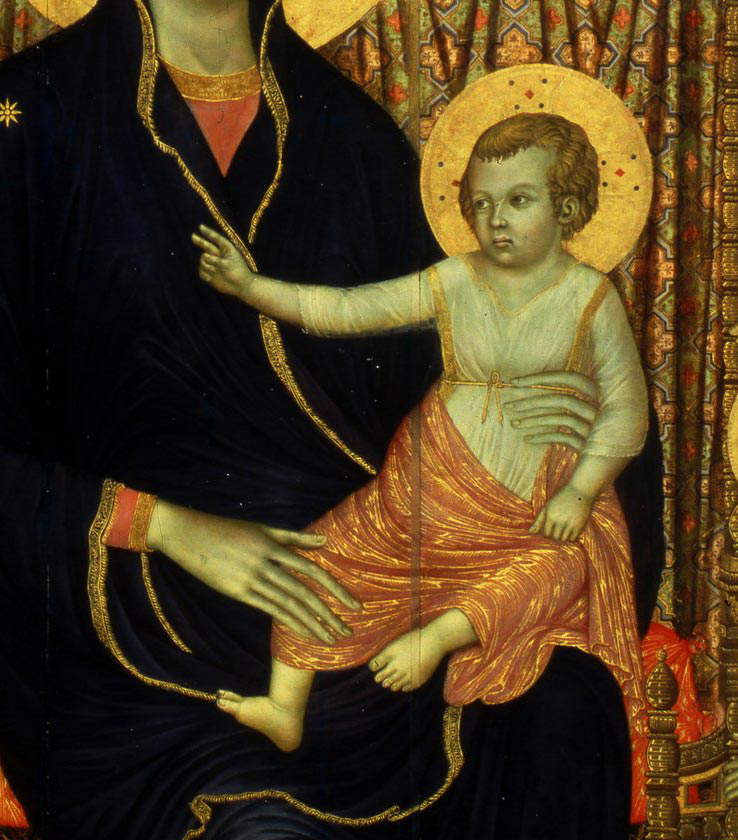 |
| Duccio di Buoninsegna, Madonna Rucellai, detail |
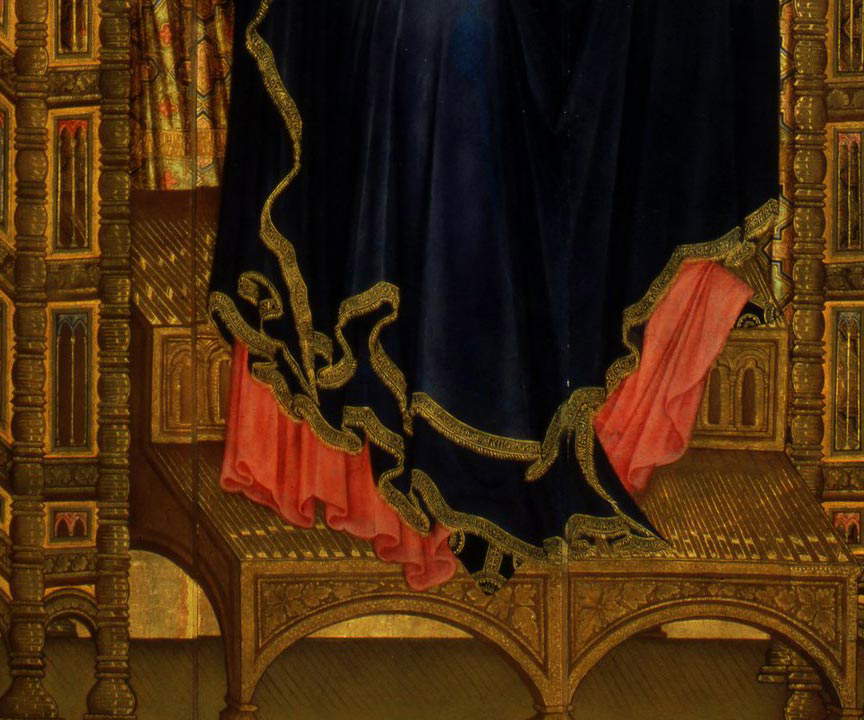 |
| Duccio di Buoninsegna, Madonna Rucellai, detail |
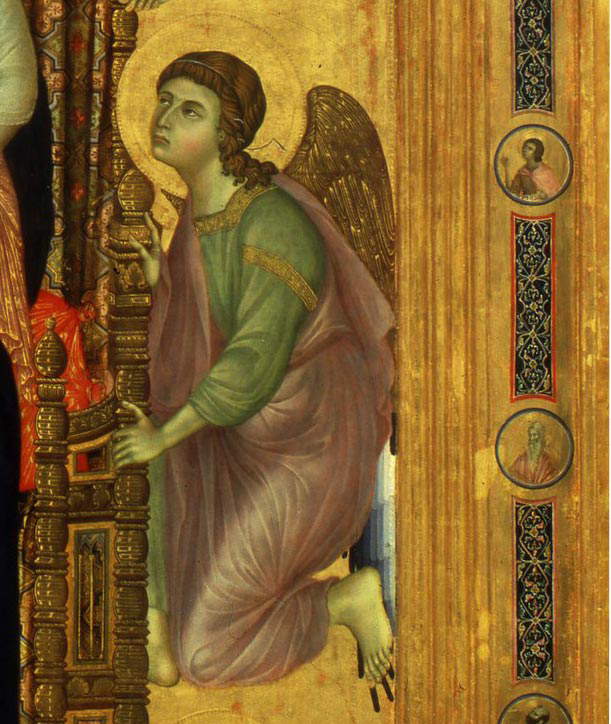 |
| Duccio di Buoninsegna, Rucellai Madonna, detail |
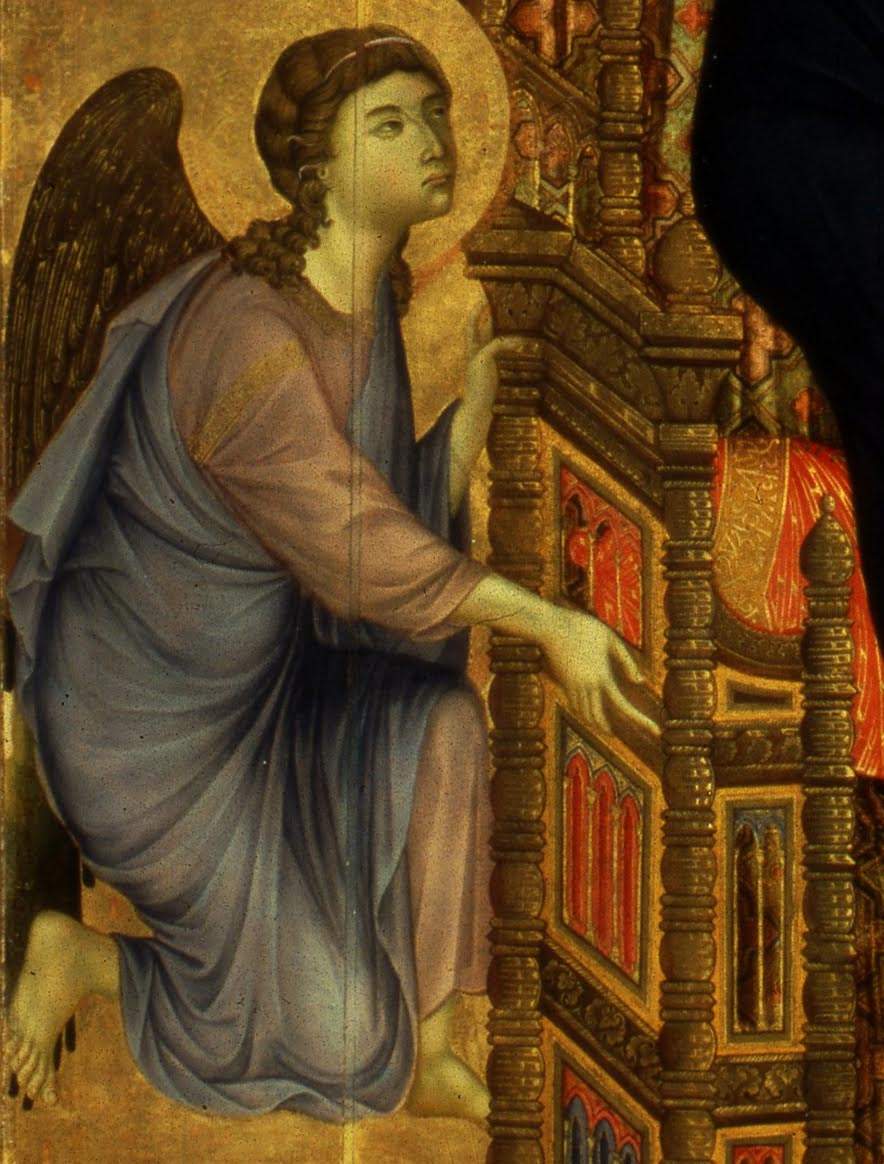 |
| Duccio di Buoninsegna, Rucellai Madonna, detail |
“Lamore degli ornamenti, anzi della loro profusione,” summarized Adolfo Venturi in his Storia dell’arte italiana comparing Duccio and Cimabue, "noticeable in Duccio in the jeweled and embroidered hemlines of the Virgin’s mantle, and likewise in the Madonna Rucellai, not in those of the larger and more austere Cimabue. Sticking to a Byzantine type, Duccio places in the drape, at the top of the head and also on the Virgin’s right shoulder, a star, according to the ancient classical way of distinguishing heroes favored by fate. Cimabue does not resort to the symbol. The mantle of the Virgin of this master is in broken lines; that of Duccio closes in the middle of the breast, descending in sinuous, calligraphic lines from the sides of the cheeks, and falling from the knees down with the multiplied curves of the orlature: such a form is found in the Rucellai Madonna. The Child in Cimabue’s paintings dresses as a Roman: he is wrapped in the pallium which, covered his left shoulder, essays around his back, comes out broadly uncoiled at the right arm, and wraps him halfway around the body. Duccio uses veils instead for the Child’s tunic, and the mantle, which covers him from half the person down, is any drape, a shawl. Cimabue gives the Child the kneecap of the law; Duccio, as much in the Rucellai Madonna as in his famous Siena altarpiece, has him stick to his own clothes with his left hand. And while the type of Jesus, in the former’s work, is strong, Roman, imperious ; in the latter’s he is plump and childlike. In the Rucellai panel the divine Pargolo blesses slowly, looking to one side, almost distracted; in the other of the Louvre he has a broad gesture, his gaze in front of him."
Again, Venturi focused on the features of the Virgin, which he thought were very similar, both of Byzantine derivation: "but in the Rucellai Madonna,“ the great art historian noted, ”there is less compression at the root of the nose, which Cimabue marks with ununghiata, just as he is wont to mark everything, rough and strong. The mouth, wide in Cimabue, in Duccio is short, with the ends less drooping and accentuated with dark.“ Then observe the angels, ”mystical“ those of Duccio, ”country“ those of Cimabue, lacking that ”devout grace“ of the Sienese: ”the necks of Cimabue’s angels are strong, cylindrical, not truncated cone-shaped, slender as in Duccio; the hands of that one are more open-fingered and bony and narrow at the tips, with the indication of joint marks; the hair has the tufts of cross locks on the forehead, while Duccio cuts the hair and more neatly styles it. Frequently in the Florentine master there are transverse lines, for example, in the fascione formed by the mantle draped over the breasts of the angels and in the contours of the garments ; in the Sienese master the lines run in curves and coils." Luciano Bellosi noted several affinities, however, for example “a remarkable consonance in the preference for a type of drapery that wraps the bodies with light fabrics that fold thickly ; the stupendous quiver of long, dense folds of the mantle that swathes the Louvre Madonna has no counterpart in the Rucellai Madonna, in which the modeling of the mantle has disappeared, but it has extraordinary counterparts in the angels’ draperies, transparent and impalpable,” or the “idea of the ornate frame of decorative lists alternating with rods with half-sacred figures” (and which Cimabue would abandon, however, in the Majesty of Sanata Trinita).
However, despite his refinement and preciosity, despite the abundance of gold and diaphanous colors, Duccio also proves himself to be an artist to some extent attentive to the natural. And not only because of the choice of arranging the throne in tralice, in order to communicate to the relative, in an empirical way, the sense of the third dimension. Contributing to the same effect are the skillful shading (especially that of the drape covering the throne) and the ability to know how to distribute the lights. Of course: the interest that Duccio shows in space has nothing to do with that evident in Giotto’s Madonna di Ognissanti, which in the Uffizi can be admired in the same room. In Giotto’s Maestà (perhaps the first “flesh” Madonna in the history of art), the composition is already oriented toward a highly effective intuitive perspective that denotes a radically different spatial approach than Duccio’s, and which demonstrates how Giotto intended to vigorously renew the painting of his time. The Madonna of All Saints, art historian Angelo Tartuferi has written, is a particularly revealing work of the “novelties in the field of spatial definition introduced by Giotto in the painting of the time, particularly in the setting of the throne, whose three-dimensionality gives depth to the space in which the scene is set. But also in the delicately shaded faces, in the draperiesp esant, in the painted figures themselves a new corporeity is marked, made of solid volumes, and equally real appear the materials represented: see for example the wooden plane on which the Virgin’s feet rest.”
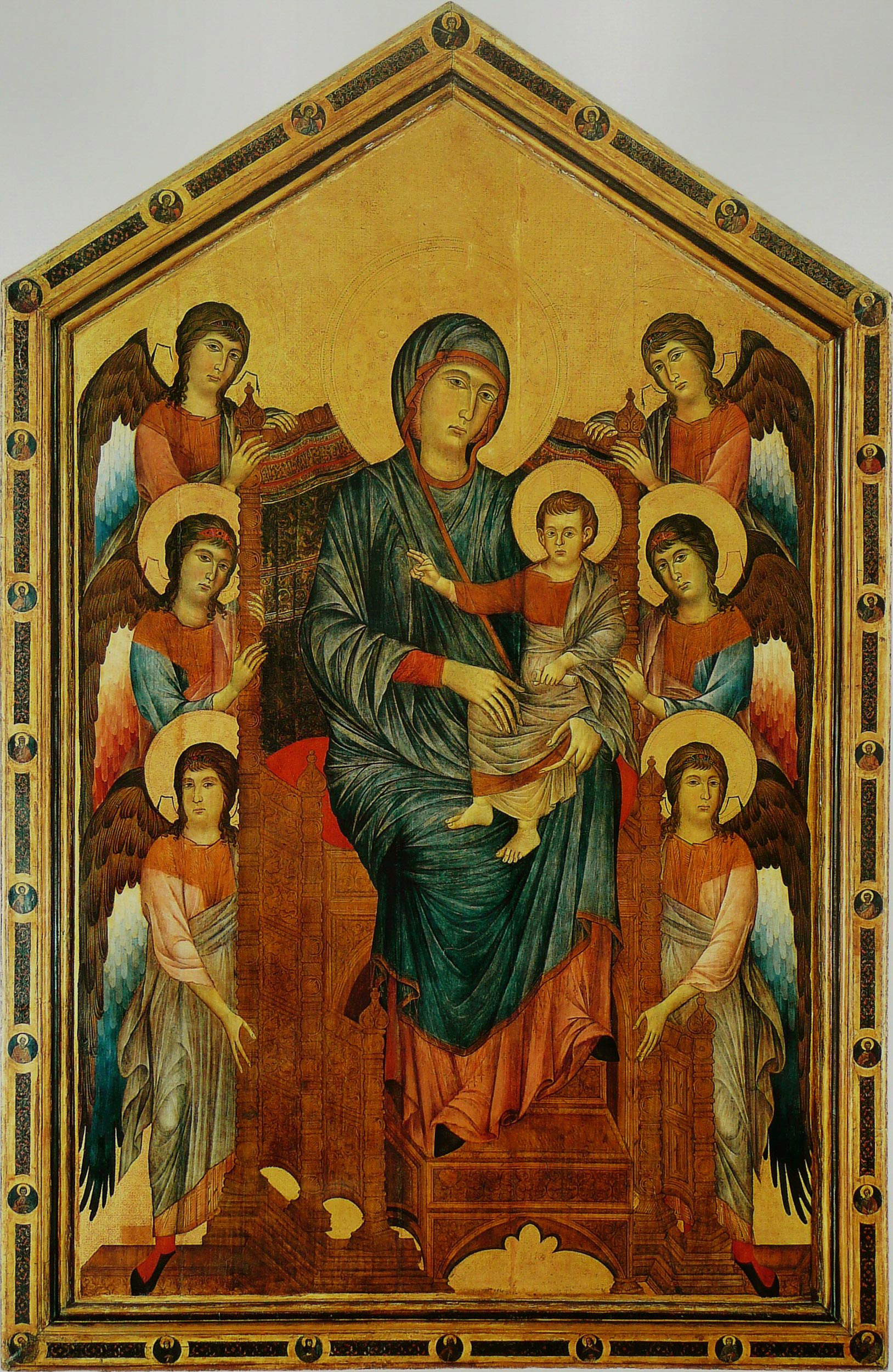 |
| Cimabue, Majesty (ca. 1280; tempera on panel and gold ground, 424 x 276 cm; Paris, Louvre) |
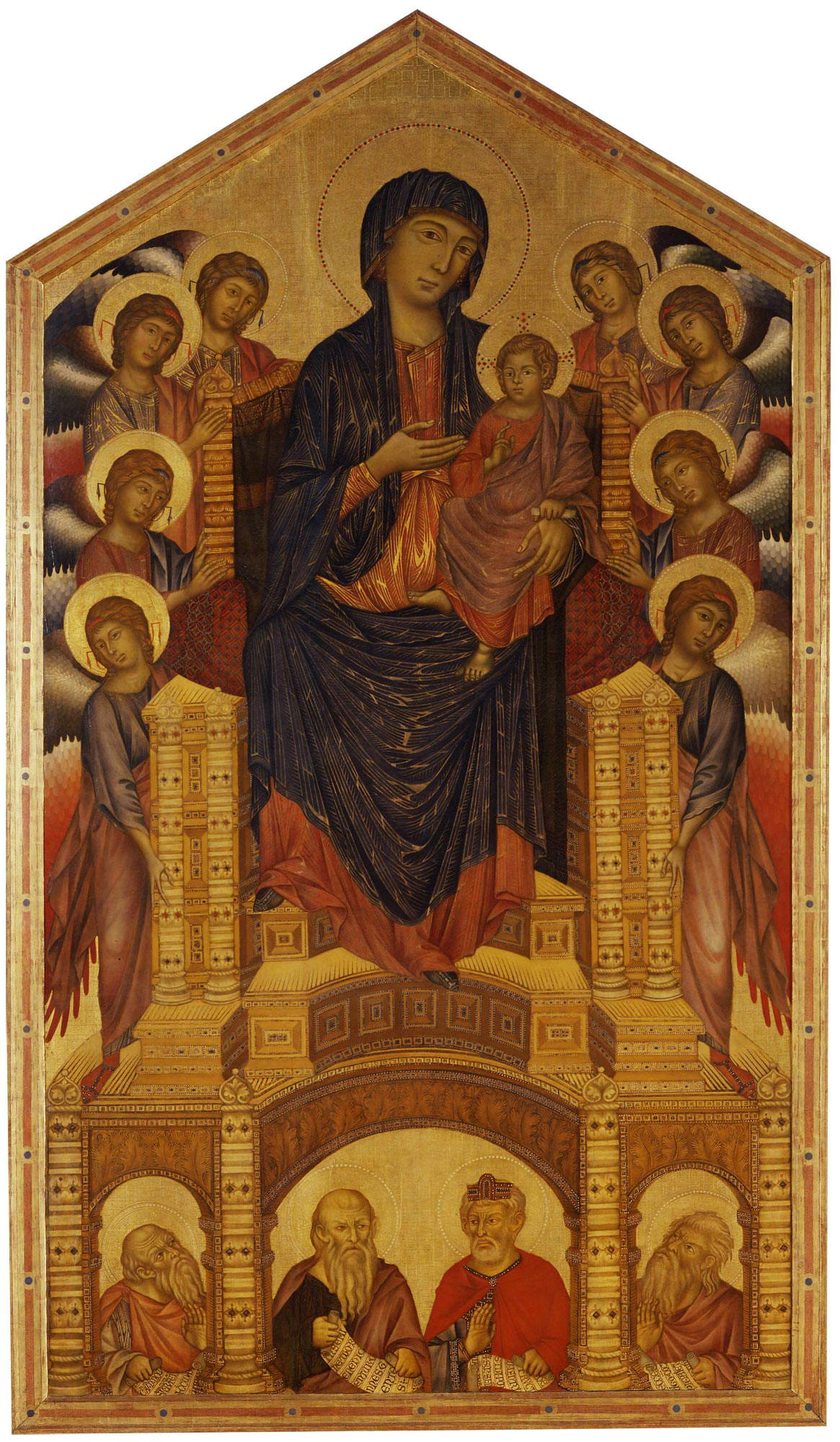 |
| Cimabue, Madonna and Child Enthroned and Prophets known as Majesty of the Holy Trinity (c. 1290-1300; tempera on panel and gold ground, 384 x 223 cm; Florence, Uffizi Gallery, inv. 1890 no. 8343) |
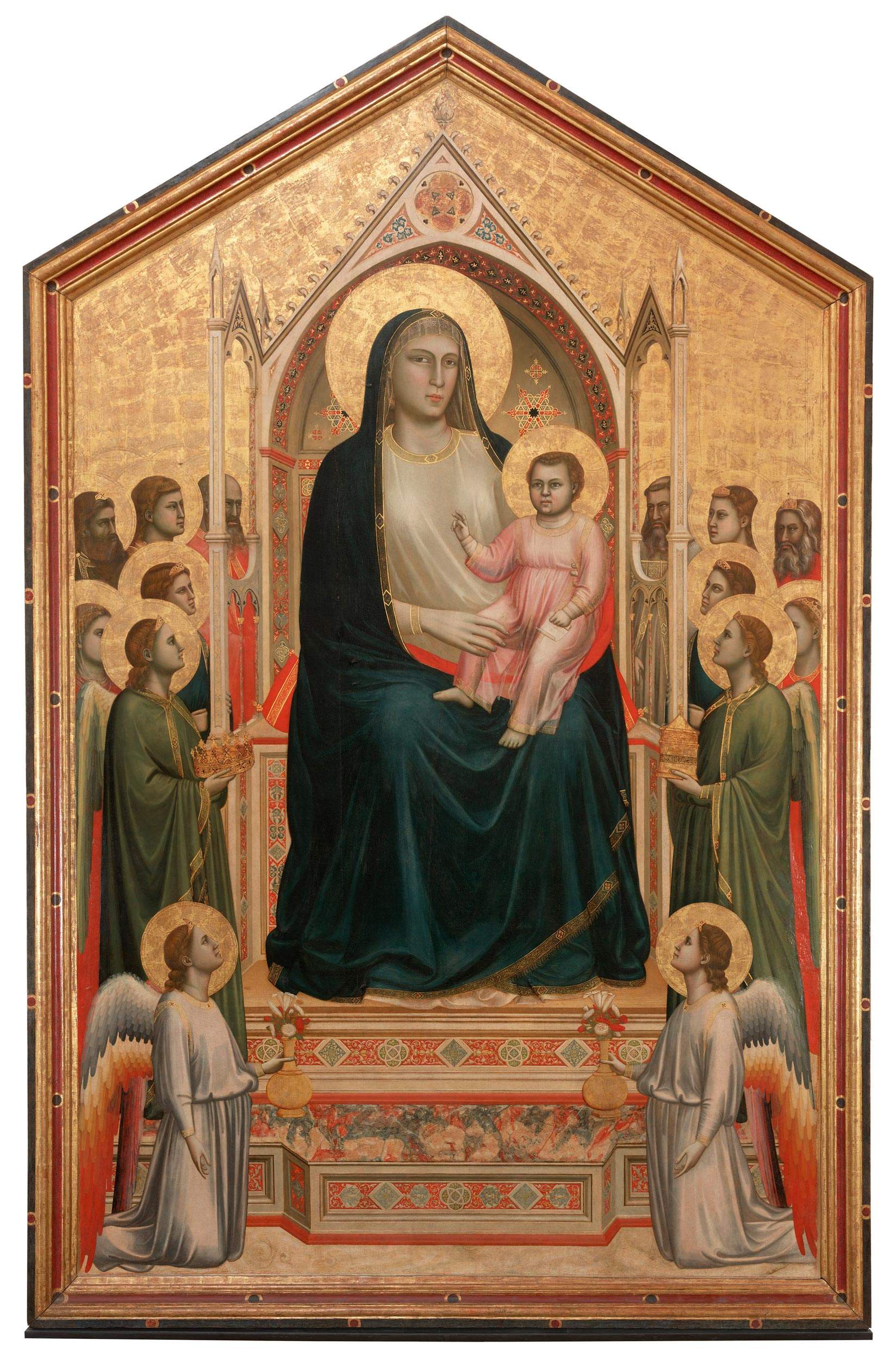 |
| Giotto, Madonna and Child Enthroned, Angels and Saints known as the Majesty of All Saints (c. 1300-1305; tempera on panel and gold ground, 325 x 204 cm; Florence, Uffizi Gallery, inv. 1890 no. 8344) |
Even from a comparison with the works that flank the Rucellai Madonna in the Hall of Majesties in the Uffizi, it is apparent to all that Duccio’s work is of truly exceptional dimensions: and it is no coincidence that it is the largest thirteenth-century panel known to us. A question may therefore arise: why did the Laudesi have the need to commission such a large work from the Sienese painter? In one of his last contributions, published in 2006 in the journal Prospettiva, Bellosi launched an interesting new proposal about the original function of the Rucellai Madonna, based on this assumption. Such dimensions, Bellosi hypothesizes, bring to mind a precise circumstance, namely the fact that, at the time the Madonna Rucellai was made, Santa Maria Novella was becoming the largest church in Florence (by 1285, the apse and transepts had come to an end). At that time, the Cathedral was still the small church of Santa Reparata (to see the laying of the foundation stone of Santa Maria del Fiore would have to wait until 1296), and the other great Florentine church, Santa Croce, had not yet been built. According to Bellosi, therefore, the panel was not intended for the chapel of San Gregorio, nor for the Society of the Laudesi, “but rather for the church of Santa Maria Novella”: the Society, in other words, “offered the church of Santa Maria Novella, which was becoming immense, an image of the Madonna of a size appropriate to the immensity of the space that the new church was occupying.”
Indeed, there would be grounds to support the hypothesis, according to Bellosi. There is the fact that the Dominican confraternities named after Our Lady were contributing to the expenses for the construction of churches linked to the order (and a huge table like the Rucellai Madonna could well have been a contribution to the growth of the building of worship). There are the documents that testify to the copious bequests by members of the Society to the church and convent of Santa Maria Novella. There are also some notes that omit the links between the Rucellai Madonna and the Society of the Laudesi, but take care to emphasize the exceptional nature of the altarpiece. The fact that Giotto’s Crucifix is also monumental in size, and therefore must have concurred with the same goals. Indeed, often panels with Majesties and crucifixes were ... paired: even the Madonna of Ognissanti, Bellosi recalls, was accompanied by a crucifix produced by Giotto’s workshop, which remains today in the church of Ognissanti in Florence. And of why the work was commissioned from Duccio, Bellosi had an opinion of his own: he could be assigned the decoration of the two lunettes in the chapel of San Gregorio (as Boskovits and Wilkins had done before him), since the 1905-1906 restorations brought to light traces of the thirteenth-century decoration later repainted when the chapel passed to the Bardi. Duccio would have been hired for the chapel of San Gregorio after being noted as a collaborator of Cimabue, and one might think, the scholar imagined, that the Laudesi had been so convinced of the result that they entrusted him with the Rucellai Madonna. However, it is difficult to establish with certainty the authorship of the wall paintings, since they are so badly ruined. But it is a hypothesis of certain fascination.
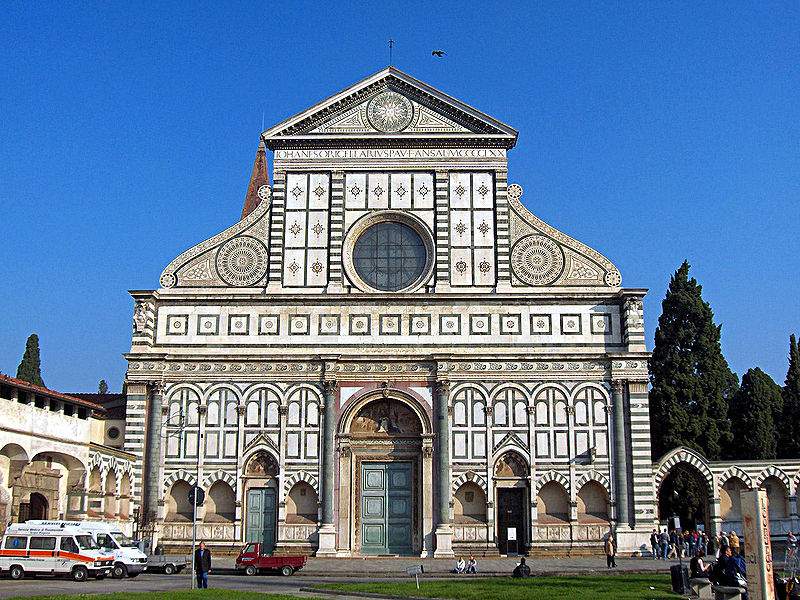 |
| The basilica of Santa Maria Novella. Ph. Credit Georges Jansoon |
 |
| Santa Maria Novella, the Bardi Chapel. Ph. Credit Francesco Bini |
 |
| Santa Maria Novella, Bardi Chapel, the 14th-century frescoes attributed to Pseudo Dalmasio. Ph. Credit Francesco Bini |
 |
| Santa Maria Novella, Bardi Chapel, one of the two lunettes with the decoration attributed to Duccio di Buoninsegna. Ph. Credit Francesco Bini |
Recently the Rucellai Madonna has returned to... topical, since in May 2020 Uffizi director Eike Schmidt had provocatively floated the idea of returning it to the church of Santa Maria Novella. “Certainly at the Uffizi this monumental painting offers the possibility of a stylistic comparison with the two altarpieces by Cimabue and Giotto,” Schmidt said, “but its absence from Santa Maria Novella takes away an essential part of its history and its overall meaning. I hope for a broad, open, public and unprejudiced debate on the advisability of returning the work to the basilica of Santa Maria Novella for which it was conceived and painted (and not of placing it a phantom and expensive new museum, as has been proposed: then it might as well be left in the Uffizi).”
The debate, in fact, has been there, although, it must be reiterated, it recurs cyclically: it had been discussed in the 1990s with the same proposal launched by Giovanni Bonsanti, and then again in 2004, when the then councillor for culture of the Municipality of Florence, Simone Siliani, took the occasion of the restoration of the Bardi Chapel to call for the return of the Rucellai Madonna to the church: “There is no reason in the world,” he had said, “why the Rucellai Madonna should not return to her place of origin.” Siliani emphasized that Santa Maria Novella could offer all the necessary conditions to allow the return of the panel to the church. But the then superintendent of the Polo Museale Fiorentino, Antonio Paolucci, had taken sides against the hypothesis: "The Rucellai Madonna,“ he replied, cutting it short, ”is fine in its current location, because it is part of a now-historicized ensemble. The room where it is displayed also houses the Majesties of Cimabue and Giotto. It was designed by Giovanni Michelucci in the early 1950s and has great historical and cultural value because it explains the historical development of the representation of the Majesty." And sixteen years later, Paolucci has reiterated his opposition to the eventual operation, while declaring himself, in principle, in favor of restoring it to its places of origin: here, however, the issue is different, because the Sala delle Maestà is also a masterpiece of museography, and it is a room that now also represents, in its own way, a historical context (this is the argument that is opposed by those who are against the return of the Rucellai Madonna to Santa Maria Novella).
How have other members of the field reacted? Art historian Timothy Verdon, director of the Museo dell’Opera del Duomo in Florence, told the newspaper Avvenire that the return would be “a revolutionary proposal that reverses the museum path of sacred art in recent centuries. Already in the seventeenth century people had begun to musealize great altarpieces by making them part of princely collections. Bringing an altarpiece back into a church and especially over the altar, even if it is no longer used, means highlighting the liturgical function of the image: for example, in the Rucellai Altarpiece the link between the Eucharistic body and the body of the Child Jesus would return legible.” A “healthy provocation, an opportunity to reflect on a different way of presenting art, to introduce people to the deeper meaning. If even in the end only one work is relocated, it would still be a success.” The director of the Museo Diocesano Tridentino, Domenica Primerano, on the other hand, assessed the issue from a broader perspective: “the issue is part of a path that has been involving the Italian museum sphere for some time, where people are thinking about an approach to works in museums made up of narratives as well as historical-artistic elements. There is a shift in approach to sacred art, with a narrative that gives back to the work all its dimensions. Today, therefore, we are more ready to move in another way. The proposal enters into this new logic, perhaps forcing our hand wants to tell us exactly that: to give these works, wherever they are, a different and more complete look.” One who was very supportive was critic Vittorio Sgarbi: “He is a thousand times right,” he said of Schmidt.
However, the return of the Rucellai Madonna would also be problematic due to the fact that, as it turns out, we do not know the exact original location of the altarpiece in the church, and the fact that Santa Maria Novella has undergone major changes since 1285. In short: it has been discussed many times, but the Rucellai Madonna has never left the Uffizi and we can assume that it will remain there for a very long time.
Warning: the translation into English of the original Italian article was created using automatic tools. We undertake to review all articles, but we do not guarantee the total absence of inaccuracies in the translation due to the program. You can find the original by clicking on the ITA button. If you find any mistake,please contact us.